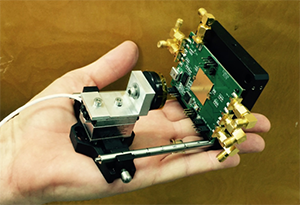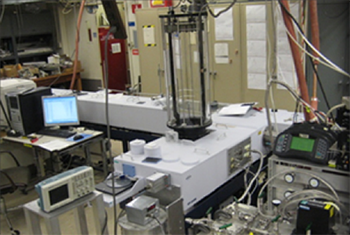

Most of our knowledge of the universe is based upon interpretation of light detected after interaction with a remote system. Molecules interact with light in a variety of ways and enable chemical and physical aspects of remote systems to be discerned via molecular spectroscopy. In the molecular spectroscopy laboratory a variety of instruments combine cutting edge technical expertise with extreme environment chambers to enable the elucidation of molecular spectra under conditions exemplary of environments found in space. This laboratory data builds the foundation of knowledge which is then extended to remote objects observed with NASA instrumentation.
Quantum mechanics plays a deep role in the nature of molecular spectra. When classical concepts such as the conservation of angular momentum and conservation of energy are applied to the quantum world, a set of rules governing the observable molecular spectra emerges. Because each molecule has a unique arrangement of atoms, the observable spectra are unique and high-resolution gas-phase measurements provide clear fingerprints for identification of gases in remote environments. The JPL spectroscopy group specializes in laboratory identification and characterization of these fingerprints such that remote and in-situ sensing scientists may then act as detectives to reveal the nature of unknown material. We collect these fingerprints in databases such as the JPL millimeter and submillimeter spectral line catalog and the HITRAN database.
- Pin Chen – Research Scientist, Infrared Instrument Development, Exoplanet-Atmospheric Modeling, and Laboratory Manager
- Tim Crawford – Research and Development Specialist, Instrument Building
- Brian Drouin – Research Scientist, Laboratory Manager and Instrument Development
- Charles Miller – Orbiting Carbon Observatory Deputy Project Scientist
- Deacon Nemchick – Research Scientist and Instrument Development
- John Pearson – Herschel Deputy Project Scientist and Molecule Tamer
- Keeyoon Sung – Research Scientist, P.O.C. for IFS Bruker 125 Facility
- Shanshan Yu – Research Scientist, Ion Generation and Instrument Building
- JPL Millimeter and Submillimeter Spectral Line Catalog
- High Resolution Infrared Spectroscopy: his effort supports atmospheric remote sensing of the Earth, our Solar System (planets, moons and comets) and some astronomical bodies (such as stars and their planets, Brown dwarfs). Our research provides specific knowledge required first to design spectroscopic instruments for NASA missions and then to interpret the resulting observations. For other planets these include Galileo, Cassini, Mars Science Lab (MSL), Hubble, Spitzer, Juno as well as Earth-observing instruments such as ATMOS, TES, SAGE III, ACE, etc.
- Laser Spectroscopy: Massively Parallel, Cavity-Enhanced, Laser Spectroscopy for Planetary and Lunar Exploration (MCELS). To enhance future in-situ measurement capabilities, this effort combines frequency-comb-laser technology, cavity enhancement, and multi-heterodyne conversion to simultaneously detect a large number of trace atmospheric molecules and isotopologues with high sensitivity.
- THz Spectroscopy: The molecular spectroscopy laboratory at JPL hosts several projects employing THz spectroscopy. The technique utilizes modular multiplier chains developed at JPL (see Pushing the Frequency) or commercially. Each source supplies up to 20% bandwidth about a central frequency in the 0.2-2.7 THz range. A tunable radio-frequency is then multiplied to the THz band of choice, passed through a gas cell and detected with either a room temperature diode detector, a liquid helium cooled bolometer, or a THz mixer. Projects include studies of terrestrial gases, interstellar gases and planetary atmosphere simulations. Earth atmosphere sensors, such as the Microwave Limb Sounder observe Earthshine and utilize laboratory data to extract trace gas profiles. Astronomers sense THz radiation from distant sources with telescopes such as Herschel and SOFIA. The molecular gas emission and absorption from space is identified and quantified utilizing laboratory data. A quantitative spectrometer utilizing THz mixing technology is under development for astrobiology exploration. This sensor will search local environments for target gases that absorb THz radiation.
- Spectrometer on a Chip: Spectrometric measurements of rotational transitions are highly specific to molecular conformation and isotopic composition. Cavity enhanced techniques allow high sensitivity measurements, but the 0.1-2 THz systems necessary for matching the strongest transitions to the smallest cavity designs have never been developed. The “Spectrometer on a Chip” utilizes CMOS mm-wave technology that is small enough to reside inside a semi-confocal Fabry-Perot cavity without destroying the mode structures. Pulses of mm-wave radiation (0.1 THz is 3 mm wavelength) build up energy in the cavity that can excite molecular resonances which then ring out of the cavity following the pulse. Tuning of the system allows access to multiple species and isotopologues. The cavity design (and eventually all the electronics) fits in your hand.